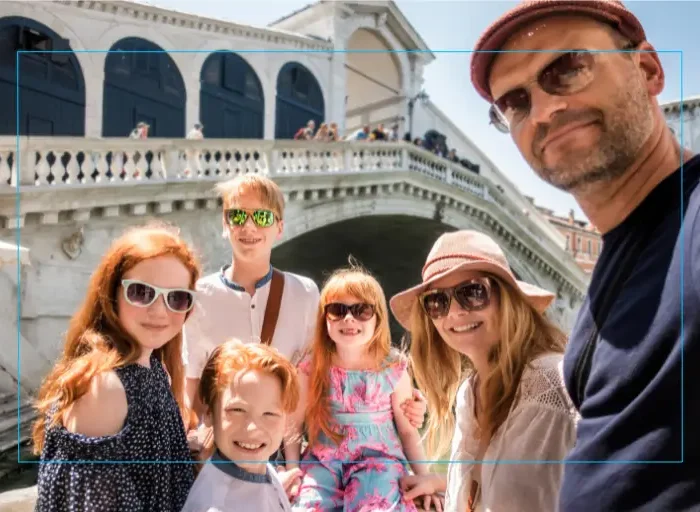Traveling, especially in the summer, can expose your eyes to dry air, bright UV rays, allergens, and long hours of screen use. At the Filutowski Eye Institute, with offices in Orlando, Lake Mary, and Daytona Beach, we want to make sure your eyes are as vacation-ready as your luggage.
Protecting your eyes before, during, and after travel ensures you’ll enjoy every view without strain, redness, or blurry distractions.
Whether you’re skiing in the Alps or lounging in Miami, choose sunglasses that:
Bonus Tip: Wraparound sunglasses offer the best coverage, especially on beaches or boats.
Always pack:
Pro Tip: Consider LASIK if your travel lifestyle makes contact lens care a hassle.
To avoid discomfort:
Wearing glasses instead of contacts on travel days can reduce irritation.
Bring:
If visiting high-altitude destinations like Switzerland or Peru, double your UV protection.
LASIK or Light Adjustable Lenses (LAL) offer travelers:
Plan your LASIK procedure a few weeks before travel to allow for healing. Most patients resume normal activities within 24–48 hours post-op.
20-20-20 Rule: Every 20 minutes, look at something 20 feet away for 20 seconds.
Bonus: Polarized sunglasses make the Aegean Sea even more breathtaking. Call:(407) 333-5111
Call:(407) 333-5111
 Locations: Lake Mary, Orlando, and Daytona Beach
Locations: Lake Mary, Orlando, and Daytona Beach
The Travel-Eye Connection: Why Eye Health Matters on Vacation ✈️
When we think about summer travel, we often prioritize comfort, sunscreen, and footwear. But clear, healthy vision is key to enjoying everything from mountain vistas to art galleries. Unfortunately, travel can introduce challenges like:- Dehydration from flights or heat
- Allergens in new environments
- Dry cabin air and changing humidity
- Extended screen time while navigating or reading
- Increased UV exposure near water or at high altitudes
Protecting your eyes before, during, and after travel ensures you’ll enjoy every view without strain, redness, or blurry distractions.
Pre-Trip Eye Care Checklist 👓
Start preparing your eyes before departure to avoid complications while abroad:- Schedule an eye exam at least 2 weeks before travel
- Update prescriptions for glasses or contacts
- Pack backup eyewear (glasses, contacts, cases, solution)
- Bring lubricating eye drops to combat dry air
- Invest in polarized sunglasses with 100% UVA/UVB protection
- Ask about LASIK or Light Adjustable Lenses if you’re tired of juggling eyewear abroad
UV Rays and Sunglasses: A First-Class Shield ☀️
UV rays can damage your cornea, lens, and retina, leading to conditions like:- Cataracts
- Photokeratitis (sunburn of the eye)
- Macular degeneration
Whether you’re skiing in the Alps or lounging in Miami, choose sunglasses that:
- Are labeled “100% UV protection”
- Are polarized to reduce glare (great for water and driving)
- Cover the full eye area to block peripheral rays
Bonus Tip: Wraparound sunglasses offer the best coverage, especially on beaches or boats.
Contacts and Travel: Proceed with Caution 👁️💧
While contact lenses are popular for travel, they also require proper hygiene, especially in foreign environments. Avoid:- Sleeping in contacts (unless approved by your doctor)
- Swimming with contacts (risk of infection)
- Using tap water to clean lenses
Always pack:
- A travel-size contact solution (in a TSA-compliant container)
- Extra pairs of lenses
- Prescription glasses as backup
Pro Tip: Consider LASIK if your travel lifestyle makes contact lens care a hassle.
Air Travel and Dry Eye Syndrome 🛫
Airplane cabins have humidity levels lower than the Sahara Desert! For your eyes, that can mean:- Itching, burning
- Blurred vision
- Sensitivity to light
To avoid discomfort:
- Use preservative-free artificial tears before and during the flight
- Blink often when reading or watching screens
- Stay hydrated and avoid alcohol/caffeine
Wearing glasses instead of contacts on travel days can reduce irritation.
Eye-Safe Destinations: Be Cautious Where You Wander 🌍
Some vacation environments pose greater risks to eye health:- Deserts and beaches = high UV exposure + sand/dust
- Mountains = increased UV at higher elevations
- Urban centers = air pollution and allergens
Bring:
- Moisture chamber goggles for dry climates
- Allergy drops if sensitive to pollen or pollutants
- Sunglasses and brimmed hats to reduce exposure
If visiting high-altitude destinations like Switzerland or Peru, double your UV protection.
LASIK for Travelers: The Ultimate Freedom 🎯
Imagine packing for Europe and leaving behind:- Contact lenses
- Solution bottles
- Reading glasses
- Prescription sunglasses
LASIK or Light Adjustable Lenses (LAL) offer travelers:
- Freedom from packing lens gear
- Confidence during active adventures (hiking, swimming, biking)
- Clear vision from sunrise to sunset
Plan your LASIK procedure a few weeks before travel to allow for healing. Most patients resume normal activities within 24–48 hours post-op.
European Summers and Eye Safety 🇪🇺
For travelers headed to France, Italy, Greece, or Spain:- Mediterranean sunlight is intense; prioritize high-quality sunglasses
- Allergens like olive pollen can irritate eyes—bring antihistamine drops
- Walking tours and museums increase screen/map usage—practice the 20-20-20 rule
20-20-20 Rule: Every 20 minutes, look at something 20 feet away for 20 seconds.
Bonus: Polarized sunglasses make the Aegean Sea even more breathtaking.
💡 Actionable Takeaways for Summer Eye Health
- Book an eye exam at least 2 weeks before travel
- Pack a full travel eye kit: drops, glasses, sunglasses, and backups
- Stay hydrated to fight dry eye
- Protect against UV rays with polarized lenses
- Consider LASIK or LAL for long-term travel convenience
📢 Call to Action
Don’t let eye discomfort steal your view. Make your vision a priority before your next getaway. Whether you’re cruising the Mediterranean or vacationing in the Florida Keys, ensure your eyes are protected, hydrated, and ready for adventure. Schedule a consultation today!Contact Us
 Call:(407) 333-5111
Call:(407) 333-5111
 Locations: Lake Mary, Orlando, and Daytona Beach
Locations: Lake Mary, Orlando, and Daytona Beach 







